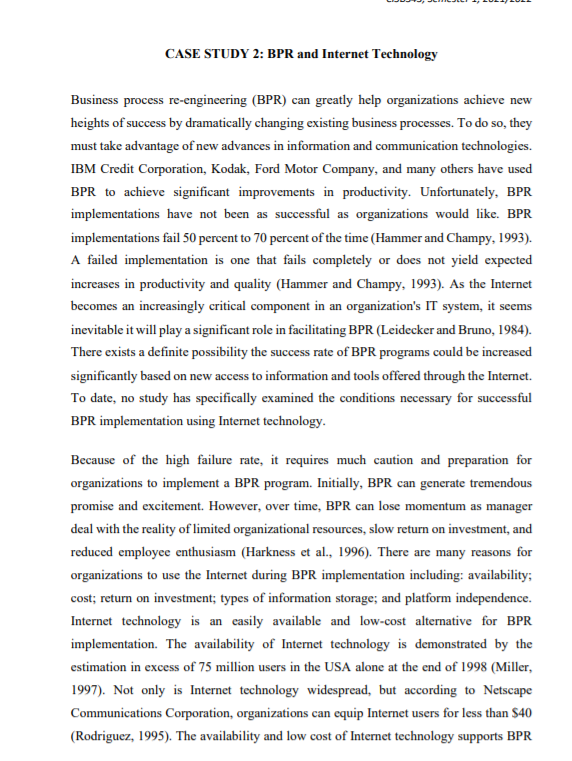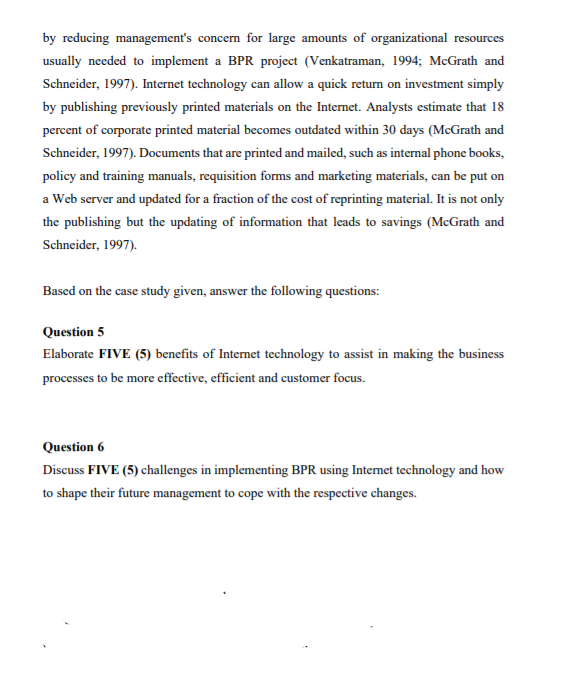Question 5 laborate FIVE (5) benefits of Internet technology to assist in making the business rocesses to be more effective, efficient and customer focus. Question 6 Discuss FIVE (5) challenges in implementing BPR using Internet technology and how o shape their future management to cope with the respective changes.
Question 5 laborate FIVE (5) benefits of Internet technology to assist in making the business rocesses to be more effective, efficient and customer focus. Question 6 Discuss FIVE (5) challenges in implementing BPR using Internet technology and how o shape their future management to cope with the respective changes.
Computer Networking: A Top-Down Approach (7th Edition)
7th Edition
ISBN:9780133594140
Author:James Kurose, Keith Ross
Publisher:James Kurose, Keith Ross
Chapter1: Computer Networks And The Internet
Section: Chapter Questions
Problem R1RQ: What is the difference between a host and an end system? List several different types of end...
Related questions
Question

Transcribed Image Text:CASE STUDY 2: BPR and Internet Technology
Business process re-engineering (BPR) can greatly help organizations achieve new
heights of success by dramatically changing existing business processes. To do so, they
must take advantage of new advances in information and communication technologies.
IBM Credit Corporation, Kodak, Ford Motor Company, and many others have used
BPR to achieve significant improvements in productivity. Unfortunately, BPR
implementations have not been as successful as organizations would like. BPR
implementations fail 50 percent to 70 percent of the time (Hammer and Champy, 1993).
A failed implementation is one that fails completely or does not yield expected
increases in productivity and quality (Hammer and Champy, 1993). As the Internet
becomes an increasingly critical component in an organization's IT system, it seems
inevitable it will play a significant role in facilitating BPR (Leidecker and Bruno, 1984).
There exists a definite possibility the success rate of BPR programs could be increased
significantly based on new access to information and tools offered through the Internet.
To date, no study has specifically examined the conditions necessary for successful
BPR implementation using Internet technology.
Because of the high failure rate, it requires much caution and preparation for
organizations to implement a BPR program. Initially, BPR can generate tremendous
promise and excitement. However, over time, BPR can lose momentum as manager
deal with the reality of limited organizational resources, slow return on investment, and
reduced employee enthusiasm (Harkness et al., 1996). There are many reasons for
organizations to use the Internet during BPR implementation including: availability;
cost; return on investment; types of information storage; and platform independence.
Internet technology is an casily available and low-cost alternative for BPR
implementation. The availability of Internet technology is demonstrated by the
estimation in excess of 75 million users in the USA alone at the end of 1998 (Miller,
1997). Not only is Internet technology widespread, but according to Netscape
Communications Corporation, organizations can equip Interet users for less than $40
(Rodriguez, 1995). The availability and low cost of Internet technology supports BPR

Transcribed Image Text:by reducing management's concem for large amounts of organizational resources
usually needed to implement a BPR project (Venkatraman, 1994; McGrath and
Schneider, 1997). Internet technology can allow a quick return on investment simply
by publishing previously printed materials on the Internet. Analysts estimate that 18
percent of corporate printed material becomes outdated within 30 days (McGrath and
Schneider, 1997). Documents that are printed and mailed, such as internal phone books,
policy and training manuals, requisition forms and marketing materials, can be put on
a Web server and updated for a fraction of the cost of reprinting material. It is not only
the publishing but the updating of information that leads to savings (McGrath and
Schneider, 1997).
Based on the case study given, answer the following questions:
Question 5
Elaborate FIVE (5) benefits of Internet technology to assist in making the business
processes to be more effective, efficient and customer focus.
Question 6
Discuss FIVE (5) challenges in implementing BPR using Internet technology and how
to shape their future management to cope with the respective changes.
Expert Solution
This question has been solved!
Explore an expertly crafted, step-by-step solution for a thorough understanding of key concepts.
Step by step
Solved in 2 steps

Recommended textbooks for you

Computer Networking: A Top-Down Approach (7th Edi…
Computer Engineering
ISBN:
9780133594140
Author:
James Kurose, Keith Ross
Publisher:
PEARSON

Computer Organization and Design MIPS Edition, Fi…
Computer Engineering
ISBN:
9780124077263
Author:
David A. Patterson, John L. Hennessy
Publisher:
Elsevier Science

Network+ Guide to Networks (MindTap Course List)
Computer Engineering
ISBN:
9781337569330
Author:
Jill West, Tamara Dean, Jean Andrews
Publisher:
Cengage Learning

Computer Networking: A Top-Down Approach (7th Edi…
Computer Engineering
ISBN:
9780133594140
Author:
James Kurose, Keith Ross
Publisher:
PEARSON

Computer Organization and Design MIPS Edition, Fi…
Computer Engineering
ISBN:
9780124077263
Author:
David A. Patterson, John L. Hennessy
Publisher:
Elsevier Science

Network+ Guide to Networks (MindTap Course List)
Computer Engineering
ISBN:
9781337569330
Author:
Jill West, Tamara Dean, Jean Andrews
Publisher:
Cengage Learning

Concepts of Database Management
Computer Engineering
ISBN:
9781337093422
Author:
Joy L. Starks, Philip J. Pratt, Mary Z. Last
Publisher:
Cengage Learning

Prelude to Programming
Computer Engineering
ISBN:
9780133750423
Author:
VENIT, Stewart
Publisher:
Pearson Education

Sc Business Data Communications and Networking, T…
Computer Engineering
ISBN:
9781119368830
Author:
FITZGERALD
Publisher:
WILEY